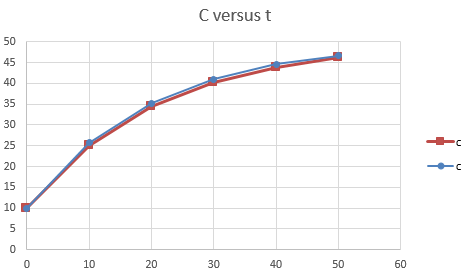
Perform the first computation in Sec. 28.1, but for the casewhere
To calculate: The solution for c if thedifferential equation for mass balance of single reactor is
Answer to Problem 1P
Solution:
The solution for c by the Heun method where
| Heun withoutiteration | |
| t | c |
| 0 | 10 |
| 10 | 25 |
| 20 | 34.375 |
| 30 | 40.23438 |
| 40 | 43.89648 |
| 50 | 46.1853 |
The solution for c by fourth-order RK method where
| 4th order RK | |
| t | c |
| 0 | 10 |
| 10 | 25.72917 |
| 20 | 35.27317 |
| 30 | 41.06419 |
| 40 | 44.57801 |
| 50 | 46.71009 |
Explanation of Solution
Given Information:
The differential equation for mass balance of single reactor is,
The values,
The analytical equation for mass balance of single reactor is,
Formula used:
The iteration formula for Heun’s method is,
The fourth-order RK method for
Where,
Calculation:
Consider the analytical equation for mass balance of single reactor is,
Substitute the values
Now, use VB code to determine c at different value of t using Heun’s method and RK4 method as below,
The following output gets displayed in the excel after the execution of the above code:

To draw the graph, use excel as below,
Step 1: Select cells from B5 to B10 and C5 to C10, then go to Insert tab and select the Line option from Charts subgroup.
Step 2: Select cells from B17 to B22 and C17 to C22, then go to Insert tab and select the Line option from Charts subgroup
Step 3: Merge the graphs.
The graph obtained is,

Hence, both the method gives the same results.
Want to see more full solutions like this?
Chapter 28 Solutions
Package: Loose Leaf For Numerical Methods For Engineers With 1 Semester Connect Access Card
- 22. The networks in parts (a) and (b) of Figure 2.23 show two resistors coupled in series and in parallel, respectively. We wish to find a general formula for the effective resistance of each network—that is, find such that . (a) Show that the effective resistance of a network with two resistors coupled in series [Figure 2.23(a)] is given by (b) Show that the effective resistance of a network with two resistors coupled in parallel [Figure 2.23(b)] is given byarrow_forwardProve the half of Theorem 3.3 (e) that was not proved in the text.arrow_forward
- Algebra & Trigonometry with Analytic GeometryAlgebraISBN:9781133382119Author:SwokowskiPublisher:Cengage
 Linear Algebra: A Modern IntroductionAlgebraISBN:9781285463247Author:David PoolePublisher:Cengage Learning
Linear Algebra: A Modern IntroductionAlgebraISBN:9781285463247Author:David PoolePublisher:Cengage Learning Elements Of Modern AlgebraAlgebraISBN:9781285463230Author:Gilbert, Linda, JimmiePublisher:Cengage Learning,
Elements Of Modern AlgebraAlgebraISBN:9781285463230Author:Gilbert, Linda, JimmiePublisher:Cengage Learning,  Trigonometry (MindTap Course List)TrigonometryISBN:9781337278461Author:Ron LarsonPublisher:Cengage Learning
Trigonometry (MindTap Course List)TrigonometryISBN:9781337278461Author:Ron LarsonPublisher:Cengage Learning



